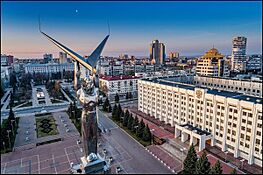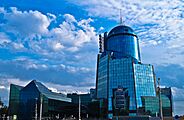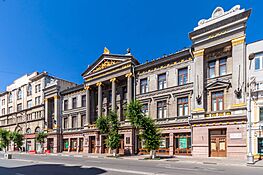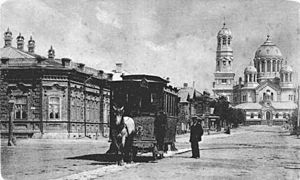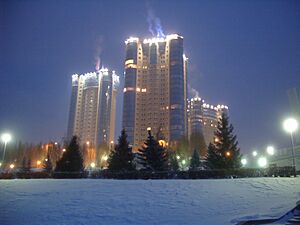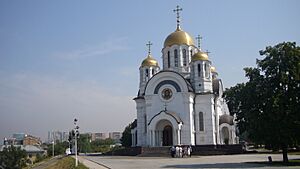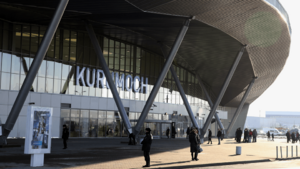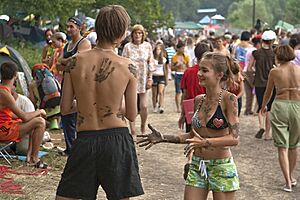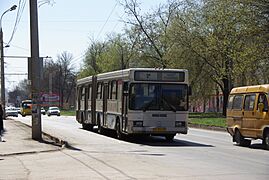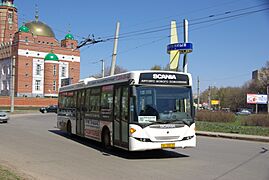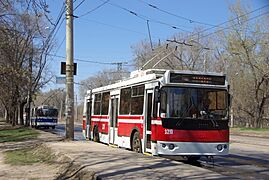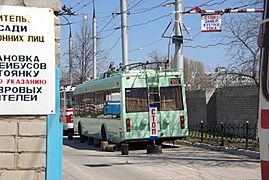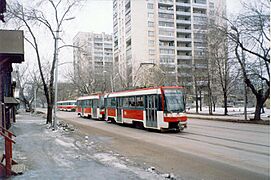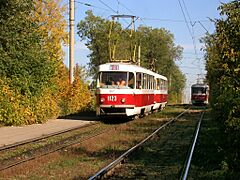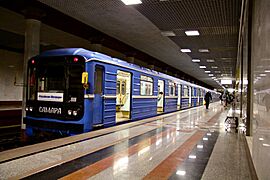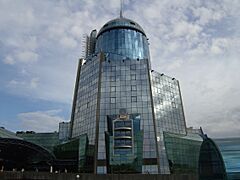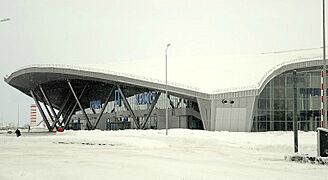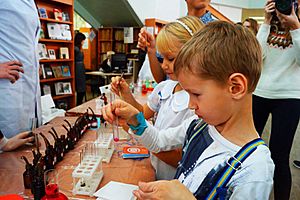Samara facts for kids
Quick facts for kids Samara (English)Самара (Russian) Kuybyshev |
|
|---|---|
| - City - | |
| [[File:
Monument of Glory, Samara
Samara skyline along the Volga river
Sacred Heart Church
Soyuz carrier rocket monument
Samara railway station
Samara Art Museum
|
|
|
|
|
| Administrative status | |
| Country | Russia |
| Federal subject | Samara Oblast |
| Administratively subordinated to | city of oblast significance of Samara |
| Municipal status | |
| Urban okrug | Samara Urban Okrug |
| Mayor | Ivan Noskov |
| Representative body | Duma |
| Statistics | |
| Area | 541.4 km2 (209.0 sq mi) |
| Population (2010 Census, preliminary) |
1,164,685 inhabitants |
| - Rank in 2010 | sixth |
| Density | 2,151/km2 (5,571/sq mi) |
| Time zone | MSK (UTC+04:00) |
| Founded | 1586 |
| City status since | 1688 |
| Postal code(s) | 443XXX |
| Dialing code(s) | +7 846 |
Samara is a large city in Russia. It used to be called Kuybyshev from 1935 to 1991. Samara is the main city of Samara Oblast. It sits where the Volga and Samara rivers meet.
Over 1.14 million people live in Samara. If you count the nearby areas, the population is about 1.22 million. It covers an area of 541.4 square kilometers. Samara is the eighth-largest city in Russia. It is also the third-most populated city along the Volga River.
Samara was once a closed city, meaning outsiders could not easily visit. Now, it is a big center for social, political, and economic activities. It is also important for industry and culture in Russia. The city hosted a big meeting between the European Union and Russia in May 2007.
Samara has a climate with hot summers and cold winters. The Volga River is very important to the city. It has been a main trade route for centuries. The riverfront is a popular place for locals and tourists to relax.
| Top - 0-9 A B C D E F G H I J K L M N O P Q R S T U V W X Y Z |
What's in a Name?
The city is named after the Samara River. This river's name likely meant "summer water" a long time ago. This suggests the river would freeze in winter. The Samara city also gives its name to the Samara culture. This was a very old group of people from around 5000 BC.
During the time of the Soviet Union, the city was renamed Kuybyshev in 1935. This was to honor Valerian Kuybyshev, a Russian Bolshevik leader. On January 25, 1991, the city went back to its original name, Samara.
Samara's Story
Early Times
Samara is in a historical area called Idel-Ural. A traveler named Ahmad ibn Fadlan visited this area around 921 AD. He was on his way to the Volga Bulgars.
A legend says that Alexius, a religious leader, visited the spot in 1357. He predicted that a great town would be built there. He also said it would never be destroyed. Samara's port on the Volga appeared on Italian maps in the 1300s. Before 1586, the Samara Bend was a place where pirates hid.
The city officially began in 1586. A fortress was built where the Volga and Samara rivers meet. This fortress protected Russia's eastern borders from nomadic groups. A customs office was set up in 1600.
Samara's port grew busy with ships. It became a center for trade and talks between Russia and the East. The city also welcomed peasant rebels led by Stepan Razin and Yemelyan Pugachyov. Important leaders like Peter the Great visited the town.
In 1780, Samara became a county town. This meant it had its own courts and treasury. On January 1, 1851, Samara became the center of the Samara Governorate. Its population was about 20,000 people. This helped the city grow in many ways.
Soviet Era
In 1935, Samara was renamed Kuybyshev. This honored the Bolshevik leader Valerian Kuybyshev.
During World War II, Kuybyshev was chosen as a backup capital for the Soviet Union. This was in case Moscow fell to the Germans. In October 1941, government groups and foreign embassies moved to the city. This plan changed in the summer of 1943. A secret bunker was built for Joseph Stalin, but he never used it.
Kuybyshev was a major industrial city. It made many weapons for the war. Factories produced aircraft, firearms, and ammunition. Hospitals became places to care for wounded soldiers. Many citizens from Samara also fought in the war.
After the war, the defense industry grew fast in Kuybyshev. New factories were built. This made Kuybyshev a closed city. In 1960, it became a center for missile production. The Vostok rocket was built here. This rocket carried Yuri Gagarin, the first person in space, in 1961. He rested in Kuybyshev after his space trip.
There is a special monument in Samara. It is an Ilyushin Il-2 aircraft. Workers in Kuybyshev built this plane in 1942. It was shot down in 1943, but the pilot survived. The plane was brought back to Kuybyshev in 1975. It stands as a symbol of the city's wartime efforts.
After the Soviet Union
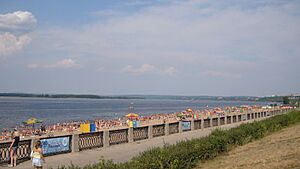
In January 1991, the city got its old name, Samara, back. Samara is still a big industrial city in Russia. It has people from many different backgrounds. The city is strong in oil and chemical industries. In September 2016, Samara was given the title "City of Labor and Combat Glory."
In 2018, Samara was one of the cities that hosted the 2018 FIFA World Cup. The games were played at the Samara Arena stadium. On July 2, 2020, Samara received the title "City of Labor Valor." A memorial complex was built in December 2021 to honor this.
City Layout
Samara started as a fortress in the 1500s. This area was already used by ships on the Volga. The fortress was built in 1586 to protect the area. It was made of wood with 11 towers.
Over time, more people moved to the fortress. Other small settlements grew nearby. By the 1600s, these settlements joined together. In 1688, Samara became a city. This led to plans for how the city would grow.
Fires damaged the city in 1765 and 1772. But in 1782, Samara got its first master plan. This plan made the streets into a grid pattern. Old buildings were removed, except for some churches and the fortress. By 1804, Samara had grown much larger.
As Samara became a major trading center, it grew even more. A railway was built in the late 1800s. This connected the city to other places. By the end of the 19th century, Samara had a clear, planned layout.
Modern City Planning
The city grew very fast. In 1937, a new plan called "Big Kuibyshev" was made. This plan aimed to make the city a huge industrial center. It planned for new main roads and city centers. Old buildings and cemeteries were removed for new public spaces.
World War II stopped the full plan. But during the war, many factories moved to Kuibyshev. This made the city's area grow by 50%. New homes were built for the factory workers.
In 1949, another plan was made. It improved the transport system and built new industrial areas. The city continued to grow quickly. By the 1950s, Samara had two main parts: the old merchant city and the new industrial area. These parts were connected by roads and railways.
Architects in Samara created beautiful buildings in the 1950s. These buildings helped connect the different parts of the city. They formed new city centers and main roads.
Weather in Samara
Samara has a climate with warm summers and very cold winters. It gets more rain in the summer than many other Russian cities. This is because of the rain and its closeness to the Volga River. Humidity levels usually range from 29% to 98% throughout the year.
The hottest temperature ever recorded was 40.4 degrees Celsius (104.7 degrees Fahrenheit). This happened during a heat wave in 2010. Because Samara is far from the ocean, its summers are very warm and winters are very cold for its location in Europe.
| Climate data for Samara (1991–2020, extremes 1852–present) | |||||||||||||
|---|---|---|---|---|---|---|---|---|---|---|---|---|---|
| Month | Jan | Feb | Mar | Apr | May | Jun | Jul | Aug | Sep | Oct | Nov | Dec | Year |
| Record high °C (°F) | 5.2 (41.4) |
6.8 (44.2) |
18.6 (65.5) |
31.1 (88.0) |
35.9 (96.6) |
38.4 (101.1) |
39.4 (102.9) |
40.4 (104.7) |
34.0 (93.2) |
26.0 (78.8) |
14.7 (58.5) |
7.3 (45.1) |
40.4 (104.7) |
| Mean daily maximum °C (°F) | −6.7 (19.9) |
−5.8 (21.6) |
0.9 (33.6) |
12.4 (54.3) |
21.4 (70.5) |
25.3 (77.5) |
27.3 (81.1) |
25.5 (77.9) |
19.0 (66.2) |
10.3 (50.5) |
0.7 (33.3) |
−5.2 (22.6) |
10.4 (50.7) |
| Daily mean °C (°F) | −9.6 (14.7) |
−9.3 (15.3) |
−2.9 (26.8) |
7.5 (45.5) |
15.6 (60.1) |
19.8 (67.6) |
21.9 (71.4) |
19.9 (67.8) |
13.8 (56.8) |
6.5 (43.7) |
−1.7 (28.9) |
−7.8 (18.0) |
6.1 (43.0) |
| Mean daily minimum °C (°F) | −12.3 (9.9) |
−12.5 (9.5) |
−6.2 (20.8) |
3.2 (37.8) |
10.3 (50.5) |
14.7 (58.5) |
16.8 (62.2) |
15.0 (59.0) |
9.6 (49.3) |
3.5 (38.3) |
−3.8 (25.2) |
−10.2 (13.6) |
2.3 (36.1) |
| Record low °C (°F) | −44.0 (−47.2) |
−36.9 (−34.4) |
−36.1 (−33.0) |
−20.9 (−5.6) |
−4.9 (23.2) |
−0.4 (31.3) |
6.0 (42.8) |
4.1 (39.4) |
−3.4 (25.9) |
−15.7 (3.7) |
−28.1 (−18.6) |
−41.3 (−42.3) |
−44.0 (−47.2) |
| Average precipitation mm (inches) | 56 (2.2) |
44 (1.7) |
42 (1.7) |
40 (1.6) |
38 (1.5) |
48 (1.9) |
47 (1.9) |
41 (1.6) |
46 (1.8) |
49 (1.9) |
46 (1.8) |
52 (2.0) |
549 (21.6) |
| Average extreme snow depth cm (inches) | 37 (15) |
54 (21) |
50 (20) |
7 (2.8) |
0 (0) |
0 (0) |
0 (0) |
0 (0) |
0 (0) |
0 (0) |
5 (2.0) |
19 (7.5) |
54 (21) |
| Average rainy days | 4 | 3 | 5 | 11 | 14 | 15 | 14 | 12 | 14 | 14 | 10 | 6 | 122 |
| Average snowy days | 24 | 20 | 14 | 4 | 1 | 0.1 | 0 | 0 | 0.3 | 4 | 15 | 22 | 104 |
| Average relative humidity (%) | 83 | 80 | 79 | 67 | 58 | 64 | 67 | 69 | 73 | 76 | 83 | 83 | 74 |
| Mean monthly sunshine hours | 64 | 102 | 149 | 214 | 305 | 303 | 310 | 275 | 190 | 108 | 47 | 46 | 2,113 |
| Source 1: Pogoda.ru.net | |||||||||||||
| Source 2: NOAA (sun, 1961–1990) | |||||||||||||
How Samara is Governed
Samara is the main administrative center for the Samara Oblast. It also serves as the center for Volzhsky District. The city itself is a special administrative unit.
The Duma of Samara Urban Okrug is like the city council for Samara. It has 37 members who are elected for five-year terms. Since 2015, people first elect local deputies. These deputies then choose the representatives for the Duma.
The Samara City Duma was first created in 1870. This happened after some big changes in how the city was run.
People of Samara
| Historical population | ||
|---|---|---|
| Year | Pop. | ±% |
| 1897 | 90,000 | — |
| 1926 | 171,818 | +90.9% |
| 1939 | 390,488 | +127.3% |
| 1959 | 806,356 | +106.5% |
| 1970 | 1,044,849 | +29.6% |
| 1979 | 1,216,233 | +16.4% |
| 1989 | 1,254,460 | +3.1% |
| 2002 | 1,157,880 | −7.7% |
| 2010 | 1,164,685 | +0.6% |
| 2021 | 1,173,299 | +0.7% |
| Source: Census data | ||
In 2021, Samara had 1,173,393 people living there. This was a slight increase from 1,164,685 people in 2010.
Most people in Samara are Russians. Other groups include Tatars, Armenians, Uzbeks, and Tajiks.
Religions in Samara
Samara is a city with many different religions. Most people are Orthodox Christians. There are also groups of Armenian Apostolic Christians, Catholics, Protestants, Muslims, and Jews.
Samara's Economy
Samara is a very important industrial city in its region. It is one of the top ten Russian cities for income and factory production. Samara is famous for making things related to space. This includes rockets and satellites at the Progress State Research and Production Rocket Space Center.
The city also makes engines, cables, and aircraft. Other products include aluminum, chemicals, and power stations. Samara produces bearings, drilling bits, and electrical equipment. You can also find truck cranes and building materials made here. Famous food products include chocolates from the Russia Chocolate Factory and local beers.
Culture and Fun
Samara has many places for arts and entertainment. There is an opera and ballet theater. You can also find a philharmonic orchestra hall and five drama theaters. The city has a natural history museum and an art museum.
Because of its role in space, Samara has a space museum called Cosmic Samara. There is also an exhibition about aerospace history at Samara State Aerospace University. Many new art galleries have opened in the 2000s.
Alabin Museum
The Samara Regional Museum of Local History is one of the oldest museums in the Volga region. It was started on November 13, 1886. The museum has large areas for displays and exhibitions. It also has a cinema hall and a library.
The museum holds about 230,000 items. These include old tools, fossils, minerals, and animal collections. There are also items about local traditions and cultures. Visitors can see exhibits on nature, ancient history, and the lives of local people.
One part of the Alabin Museum is the House-Museum of Vladimir Lenin. This was once a merchant's house from the late 1800s. The Ulyanov family, including Vladimir Lenin, lived here in 1893. The museum opened in 1940. It shows how the Ulyanov family lived.
Another part is the Exposition Museum of Art Nouveau. It opened in 2012. This museum is in the old mansion of Alexandra Kurlina. The building still looks like it did when it was built. It shows the beautiful style of Art Nouveau.
The House-Museum of Mikhail Frunze opened in 1934. It tells the story of the Russian Civil War. It shows information about the different groups who fought. This includes "The Reds," "The Whites," and "The Greens."
Samara has a lively rock music scene. It hosts cool festivals like Protoka, Metafest, and Volgafest.
Public Events
Many international festivals and events happen in Samara.
- Grushinsky festival is an annual folk song festival. It started in 1968. It takes place near Samara, by the Mastryukovo lakes. The festival is named after Valeri Grushin, a singer who died saving friends.
- Rock over Volga was a big international rock festival. It happened every year from 2009 to 2013. Famous bands like Skunk Anansie and Rammstein played there.
- Metafest is an annual outdoor music festival. It has been held at the Mastryukovo lakes since 2007.
City Buildings
The buildings in Samara date back to the 15th and 16th centuries. Many old wooden buildings had fancy decorations. The city had over 2000 important cultural buildings. However, some unique old buildings were replaced by modern ones after the 1990s.
Sports in Samara
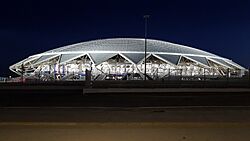
Samara has several sports teams:
| Club | Sport | Founded | Current League | League Tier |
Stadium |
|---|---|---|---|---|---|
| Krylia Sovetov | Football | 1942 | Russian Premier League | 1st | Samara Arena |
| CSK VVS Samara | Ice Hockey | 1950 | VHL | 2nd | Kristall Ice Palace |
| Samara | Basketball | 1976 | Russian Basketball Super League 1 | 2nd | MTL Arena |
| Krylia Sovetov | Beach Soccer | 2010 | Russian Beach Soccer Championships | 1st | Volga Stadium |
| Dinamo-Samara | Futsal | 2018 | Russian Futsal Super League | 1st | MTL Arena |
Samara is also a popular place for Ice speedway races. The city's team won the Russian Ice Speedway Premier League in 2012/13. Samara was one of the eleven cities that hosted the 2018 FIFA World Cup. Six matches were played at the new Cosmos Arena stadium. The stadium can hold 45,000 people.
During the World Cup, a FIFA Fan Fest was held in Kuibysheva Square. Up to 20,000 fans could gather there at one time. Three new training fields were built for the World Cup. Two major roads were also fixed before the event.
Getting Around Samara
Samara is a big transport hub. This means it's a central place for travel.
Roads
Samara is on the M5 highway. This is a main road connecting Moscow to the Ural region.
Trains
You can travel by train to Moscow and other big Russian cities. The railway station building was finished in 2001. It has a unique look.
River Travel
Samara is a major river port. This is because it is located where the Volga and Samara rivers meet.
Air Travel
The Kurumoch International Airport has flights across Russia and Central Asia. It also has flights to cities like Frankfurt, Prague, Helsinki, and Dubai.
Public Transport
Public transportation in Samara includes the Samara Metro, trams, buses, and trolleybuses. Local trains also serve the areas outside the city center.
The Samara Tram system is very large. It covers most of Samara. It first opened in 1915. It now has 25 lines and 423 tram cars. Most trams are Tatra T3SU models.
The Samara Metro is an underground train system with one line. It opened in 1987. Its line has been expanded and now has 10 stations. An 11th station, "Teatralnaya," has been under construction since January 2022.
Gallery
-
Scania OmniLink bus
Learning in Samara
Samara has 188 schools, including high schools and colleges. It is a big center for education and science in the Volga area. There are 12 public and 13 private universities. There are also 26 colleges.
Samara State Aerospace University (SSAU) is one of Russia's top engineering schools. Its teachers and graduates have been very important to Russia's space program. Samara State University is also a respected university. It has good programs in Law, Sociology, and English.
Scientific research is also done in Samara. The Samara Research Center of the Russian Academy of Sciences has several institutes. These include the Physical Institute and the Image Processing Systems Institute.
Samara State Technical University (SamGTU) was founded in 1914. It has 11 departments and over 20,000 students. The Samara State Academy of Social Sciences and Humanities started in 1911. It offers many different subjects in its 12 departments.
Special Recognition
The asteroid 26922 Samara was named after the city and the river on June 1, 2007.
Famous People from Samara

Many notable people have come from Samara, including:
- Violetta Khrapina Bida (born 1994), an Olympic fencer.
- Mark Feygin (born 1971), a lawyer and human rights activist.
- Mimi Kagan (1918–1999), a modern dancer and choreographer.
- Ilya Kan (1909–1978), a chess player.
- Dmitry Muratov (born 1961), a journalist and winner of the 2021 Nobel Peace Prize.
- Anastasia Pavlyuchenkova (born 1991), a professional tennis player.
- Dmitry Shostakovich (1906–1975), a famous composer and pianist. He lived in Samara during World War II.
- Aleksey Nikolayevich Tolstoy (1882–1945), a writer of science fiction and historical novels.
Samara's Sister Cities
Samara is connected with other cities around the world. These are called twin towns:
 Hefei, Anhui, China (2015)
Hefei, Anhui, China (2015) Heihe, Heilongjiang, China (2012)
Heihe, Heilongjiang, China (2012) Krimml, Salzburg, Austria (2010)
Krimml, Salzburg, Austria (2010) Palermo, Sicily, Italy (2008)
Palermo, Sicily, Italy (2008) Stara Zagora, Stara Zagora Province, Bulgaria (1992)
Stara Zagora, Stara Zagora Province, Bulgaria (1992) Stuttgart, Baden-Württemberg, Germany (1992)
Stuttgart, Baden-Württemberg, Germany (1992) St. Louis, Missouri, United States (1994)
St. Louis, Missouri, United States (1994) Tongyeong, Gyeongsangnam-do, South Korea (2016)
Tongyeong, Gyeongsangnam-do, South Korea (2016) Zhengzhou, Henan, China (2002)
Zhengzhou, Henan, China (2002) Denizli, Aegean Region, Turkey (2008)
Denizli, Aegean Region, Turkey (2008)
See also
 In Spanish: Samara para niños
In Spanish: Samara para niños
- Sacred Heart Church, Samara
- Cathedral of Christ the Saviour (Samara)
- Monastery of the Theotokos of Iveron (Samara)
- Samara flag
- Samara culture
- Samara Police


